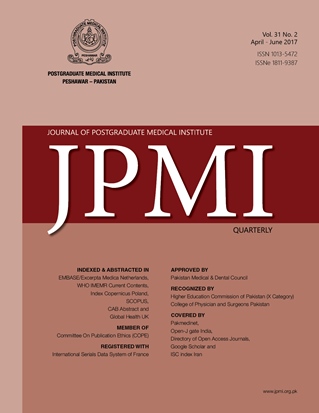OUTCOME OF ELECTRIC SHOCK INJURIES: AN EXPERIENCE AT THE LADY READING HOSPITAL PESHAWAR
Main Article Content
Abstract
Objectives: To determine the clinical presentation and outcome of accidental
electric shock injuries in patients brought to the Department of Accident and
Emergency, Lady Reading Hospital, Peshawar.
Methodology: This descriptive study was conducted in the Department of Accident
& Emergency, Lady Reading Hospital, Peshawar from 1st January 2011
to 31st December 2011.Patients with clear history of electric shock according
to the patients or attendants were included in the study through consecutive
sampling technique. Data was acquired through clinical history, physical examination
and relevant investigations. Patients who were received dead and the
attendants were not sure about the causes of death were excluded from the
study. Data were analysed and presented in the form of tables.
Results: A total of 219 patients were studied in which male and female were
161 (73.52%) and 58(26.5%) respectively. Age wise distribution showed that
106(48.4%) were in age range of 20-40 years. The majority of cases were brought
in the months of July 38(17.4%), August 44(20.1%) and September 43(19.6%).
Patients having only minor injuries were 64(29.2%) while dead were 34(15.5%).
Patient having neurosurgical injuries were 23(10.5%) while orthopaedic injuries,
poly trauma, burn injuries and cardiac arrhythmias were 21(9.6%), 19(8.7%),
11(5.0%) and 7(3.2%) respectively. Majority of patients 153(70%) were buried in
ground due to the local myth before bringing to the hospital.
Conclusion: Electric shock carries high morbidity and mortality. The majority of
electric shock injuries occured in the summer rainy season.
electric shock injuries in patients brought to the Department of Accident and
Emergency, Lady Reading Hospital, Peshawar.
Methodology: This descriptive study was conducted in the Department of Accident
& Emergency, Lady Reading Hospital, Peshawar from 1st January 2011
to 31st December 2011.Patients with clear history of electric shock according
to the patients or attendants were included in the study through consecutive
sampling technique. Data was acquired through clinical history, physical examination
and relevant investigations. Patients who were received dead and the
attendants were not sure about the causes of death were excluded from the
study. Data were analysed and presented in the form of tables.
Results: A total of 219 patients were studied in which male and female were
161 (73.52%) and 58(26.5%) respectively. Age wise distribution showed that
106(48.4%) were in age range of 20-40 years. The majority of cases were brought
in the months of July 38(17.4%), August 44(20.1%) and September 43(19.6%).
Patients having only minor injuries were 64(29.2%) while dead were 34(15.5%).
Patient having neurosurgical injuries were 23(10.5%) while orthopaedic injuries,
poly trauma, burn injuries and cardiac arrhythmias were 21(9.6%), 19(8.7%),
11(5.0%) and 7(3.2%) respectively. Majority of patients 153(70%) were buried in
ground due to the local myth before bringing to the hospital.
Conclusion: Electric shock carries high morbidity and mortality. The majority of
electric shock injuries occured in the summer rainy season.
Article Details
How to Cite
1.
Haider A, Zubair M, Abideen Z, Saima ., Ihsanullah ., Muner A, et al. OUTCOME OF ELECTRIC SHOCK INJURIES: AN EXPERIENCE AT THE LADY READING HOSPITAL PESHAWAR. J Postgrad Med Inst [Internet]. 2017 May 12 [cited 2025 Dec. 5];31(2). Available from: https://jpmi.org.pk/index.php/jpmi/article/view/1866
Issue
Section
Original Article
Work published in JPMI is licensed under a
Creative Commons Attribution-NonCommercial 2.0 Generic License.
Authors are permitted and encouraged to post their work online (e.g., in institutional repositories or on their website) prior to and during the submission process, as it can lead to productive exchanges, as well as earlier and greater citation of published work.


